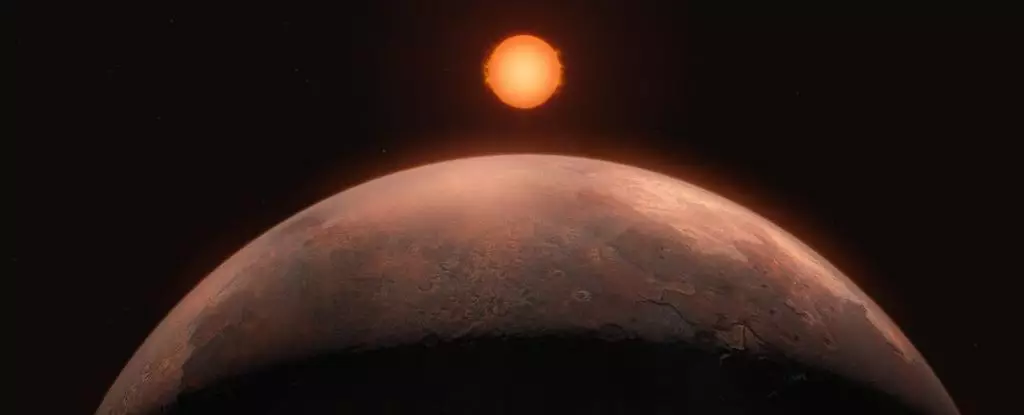Nestled just under six light-years away, Barnard’s Star (GJ 699) has captivated astronomers as it is the closest single star to our Solar System. This red dwarf, while being the most prevalent type of star in the universe, presents an intriguing backdrop for the study of exoplanets—planets that exist outside our solar system. Recent breakthroughs surrounding Barnard’s Star have shifted our understanding of planetary formations, particularly highlighting the challenges astronomers face when searching for smaller exoplanets. The most exciting revelation from this stellar neighborhood is the discovery of Barnard b, an exoplanet that challenges our detection methods and conceptions of potential habitability.
The exoplanet Barnard b, with a mass merely 37% that of Earth, stands out as a groundbreaking find in a field that predominantly focuses on larger planets. This minuscule mass is comparable to about half that of Venus or roughly 2.5 times that of Mars. The significance of Barnard b goes beyond its size; the discovery marks a pivotal moment in exoplanet research. Typically, the detection of smaller exoplanets has been a Herculean task because their gravitational influence on their host stars hardly produces the noticeable “wobbles” that larger planets do. However, the unusual dynamics associated with red dwarfs like Barnard’s Star allow for easier identification of these diminutive worlds, even as the star itself lacks the luminosity of larger, more familiar stars like our Sun.
The Discovery Process
The journey towards identifying Barnard b began with the analysis of radial velocity—an observational method that assesses how a star shifts position due to gravitational interactions with its orbiting planets. Utilizing the European Southern Observatory’s Very Large Telescope, astronomers observed periodic movements suggestive of a planetary companion. The resulting data revealed a periodicity of 3.15 days, indicating that Barnard b orbits its star in an extraordinarily tight formation of just 0.02 astronomical units.
Although initial hints of a larger, potentially habitable exoplanet around Barnard’s Star emerged back in 2018, the confirmation of Barnard b showcases how the research evolved. Reports of other nearby candidate planets heighten the intrigue surrounding the system, suggesting that we may not have fully unearthed the secrets of Barnard’s Star yet.
Despite its discovery excitement, it is crucial to address the limitations of Barnard b. The orbit is too close to its host star to support life as we know it; temperatures likely prevent the presence of liquid water on the planet’s surface, a fundamental prerequisite for life. Yet, this does not preclude the potential for habitability among potential companions further out. The presence of three additional candidates around Barnard’s Star might open avenues for discovering environments that could theoretically support life.
Even in the cold theater of space, these findings enliven our conversations about astrobiology. The detection of small, low-mass planets has historically emphasized gaseous giants; now, Barnard’s Star alters this dynamic, revealing a plethora of smaller worlds that invite consideration on their habitability. As noted by astronomer Alejandro Suárez Mascareño, there is a burgeoning belief that our cosmic neighborhood may be more populated with low-mass planets than previously recognized.
The discovery of Barnard b is merely the tip of the iceberg in the ongoing exploration of exoplanets. Scientists are eager for follow-up observations that can either confirm the existence of additional hypothesized planets or provide alternative explanations for the signals we’ve detected. Understanding our galactic neighborhood is crucial, as it might hold keys to broader questions about life in the universe and the composition of planetary systems around red dwarfs.
Furthermore, with the advent of more advanced telescopes and observational techniques, the prospects of uncovering Earth-sized planets in the near future remain tantalizing. Astronomers are determined to push deeper into the cosmos, untangling the web of signals emitted from distant stars and their planetary companions.
The discovery surrounding Barnard b serves as a deliberate reminder that while the cosmos may be inhospitable today, its many small planets may pave the way for future exploration. As researchers continue their quest, each finding enriches our understanding and sparks curiosity that may one day lead us to communicate with our galaxy’s residents—even if only to say hello to our nearest neighbors. Each discovery in this field brings with it new questions, challenging our understanding of the universe while simultaneously reigniting our sense of wonder.

